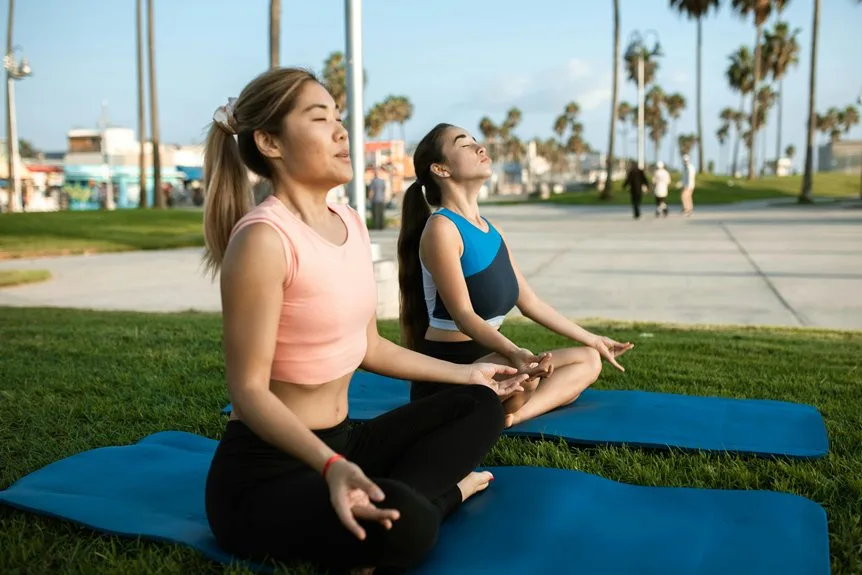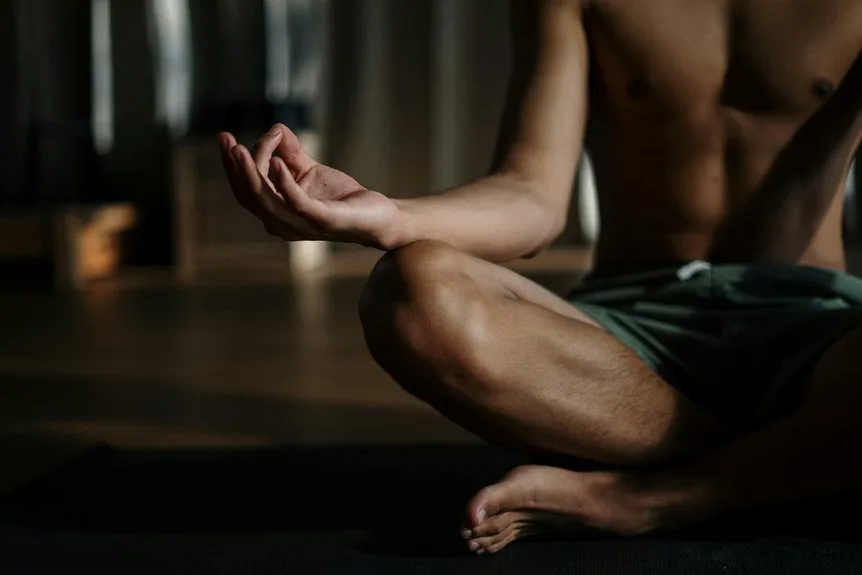Managing stress is something everyone faces, but finding the right activities can make all the difference. From simple habits like listening to calming music to more intentional practices such as mindfulness and journaling, there are plenty of ways to ease daily tension. Whether someone prefers a brisk walk in the park or the subtle scent of lavender, each method brings its own unique benefits. Curious which strategies top the list and why they work so well?
Listen to Soothing Music
Why does a simple melody sometimes seem to melt away worries? Listening to soothing music is more than just a pleasant pastime; it’s a powerful relaxation technique for stress management. When calming tunes fill the air, the body and mind respond by slowing heart rate and lowering blood pressure, helping to reduce cortisol levels.
Creating playlists of gentle genres—like classical or Celtic—can inspire emotional calmness and enhance mental wellbeing. Whether it’s a favorite song on repeat or a new find, music brings people together, offering a shared path to stress relief. For those looking to elevate their wellness journey, a personalized wellbeing journey at a retreat like Sensei Porcupine Creek could complement the relaxation music provides. For many, it’s a daily ritual that soothes and heals.
Practice Mindfulness and Deep Breathing
Ever wonder how just a few slow breaths can make the world feel a little less overwhelming? Practicing mindfulness and deep breathing offers a welcoming path to stress reduction for anyone seeking calm.
Mindfulness helps anchor thoughts in the present, while deep breathing activates the parasympathetic nervous system—nature’s own stress relief switch.
Just five minutes of breathing exercises, like the 4-7-8 method, can provide anxiety relief and emotional regulation.
These habits lower cortisol levels and build resilience over time, making stress management feel more like a shared odyssey than a solo battle.
It’s a simple practice with a powerful impact. Additionally, visiting places like the Cuyama Buckhorn, an artfully-restored roadside resort with amenities like a barrel sauna for sunset views, can enhance your relaxation journey.
Engage in Regular Physical Activity
Getting the body moving is one of the simplest ways to support emotional health, as even a stroll around the block or a quick yoga session can help lift spirits and ease tension. Regular physical activity acts like a reset button for both mind and body, helping people shake off stress and feel more in control. Taking exercise outdoors, whether it’s biking through a park or shooting hoops at a local court, adds the bonus of fresh air and a change of scenery, making the experience even more rewarding. For those seeking mineral-rich lithium waters to enhance their wellness routine, destinations like Two Bunch Palms provide a unique opportunity to unwind and rejuvenate in a serene environment.
Exercise for Emotional Health
Countless people have uncovered that moving the body does wonders for the mind. Regular exercise, whether it’s a brisk walk or gentle yoga, offers a reliable mood enhancement and helps reduce stress.
Physical activity releases endorphins, nature’s own feel-good messengers, while also lowering stress hormones like cortisol.
Over time, consistent movement enhances neuroplasticity, making the brain more adaptable for emotional regulation.
Improved sleep is another bonus, which keeps emotions in check and builds resilience.
Incorporating exercise into daily routines helps decrease anxiety and depression, supporting emotional health and creating a sense of connection, both to oneself and to others.
For those seeking a destination that embodies wellness and relaxation, Solage in Calistoga offers an ideal environment with its renowned natural hot springs and serene surroundings, perfect for rejuvenation and stress relief.
Movement Reduces Tension
While it might sound too simple to be true, moving the body really does help melt away tension. Regular physical activity, like a brisk walk or a yoga session, encourages the release of endorphins—those natural mood enhancers.
Even just 20 minutes of moderate exercise can lower cortisol, the hormone that fuels stress. Consistent movement builds endurance, sharpens cognitive function, and supports mental health by reducing anxiety and depression symptoms.
People who make exercise a daily habit often notice better sleep and feel more resilient when life gets tough. In groups or solo, movement is a powerful way to reduce stress.
Outdoor Activity Benefits
Stepping outside for a walk or bike ride does more than just stretch the legs—it invites the mind and body to unwind in unexpected ways. Outdoor activity in natural environments is a powerful tool for stress reduction, helping lower stress hormones like cortisol and enhancing mental well-being.
Whether solo or in a group, the relaxation and endurance benefits are real and lasting. Consider these three ways outdoor exercise supports wellness:
- Reduces stress hormones while promoting relaxation and emotional resilience
- Elevates endorphin production, improving mood and mental well-being
- Provides sensory stimulation, encouraging mindfulness and stress relief
Try Aromatherapy and Calming Scents
A gentle whiff of lavender or a hint of sandalwood in the air can do more than simply freshen up a room—it can actually help soothe frayed nerves and ease daily tension.
Many people find aromatherapy with calming scents like lavender, frankincense, or sandalwood to be a simple yet powerful method for stress reduction. Scent intake through diffusing scents or using essential oils can impact relaxation and mental clarity, since the sense of smell connects directly to stress-regulating brain areas.
Incorporating these practices into daily life may lower blood pressure, improve sleep, and help everyone feel a little more at ease together.
Keep a Stress-Relief Journal
Keeping a stress-relief journal gives people a place to track what sets off their stress and spot patterns that might otherwise go unnoticed.
By reflecting on daily ups and downs, users gain self-awareness, which can feel a bit like solving a mystery about their own emotions.
With these perspectives, it becomes easier to set up coping strategies that actually fit real-life situations, instead of just guessing what might help.
Track Triggers and Patterns
When it comes to handling stress, one surprisingly effective approach is to start tracking what sets those anxious feelings in motion. By using a stress-relief journal, people can spot triggers and patterns in their stress responses.
This process helps them see which coping strategies actually work, while enhancing self-awareness and emotional regulation. Over time, journaling highlights how different situations or interactions influence well-being.
To make the most of this activity, consider:
- Write down daily thoughts, emotions, and physical sensations.
- Note specific events or environments linked to stress.
- Review entries weekly to find recurring triggers and patterns.
Reflect for Self-Awareness
Ever wondered why certain moments spark stress while others barely make a dent? A stress-relief journal can make all the difference. By engaging in reflective writing, individuals invite self-awareness and mindfulness into their daily lives.
Jotting down thoughts and emotions shines a light on stress triggers and recurring patterns, nurturing self-understanding and emotional regulation. This honest process isn’t just about venting—it’s about connecting the dots.
Over time, tracking progress in a stress-relief journal helps reveal underlying causes and highlights positive coping strategies. It’s a practical, supportive way to build resilience and feel more in control, together with others facing similar challenges.
Set Coping Strategies
After taking the time to reflect and notice stress triggers, it’s only natural to wonder what to do next. One effective approach is to set coping strategies by keeping a stress-relief journal. This tool blends self-awareness with proactive problem-solving, helping people feel more connected and in control.
A stress-relief journal works best when used with reflection techniques and clear goals:
- Track stressors and emotional responses to spot patterns.
- Record positive experiences to reinforce resilience and a growth mindset.
- Use prompts to guide new coping strategies and support ongoing stress management.
Journaling makes stress management feel more personal and supportive.
Spend Time in Nature
Although life can sometimes feel overwhelming, spending time in nature offers a simple yet powerful way to melt away stress. Outdoor activities, like walking through green spaces or relaxing on a park bench, invite a sense of belonging and calm.
Nature encourages mindfulness, helping people tune into the gentle rustle of leaves or the warmth of sunlight. Even just ten minutes of outdoor time can lower blood pressure and heart rate, leading to noticeable stress reduction.
Gardening, forest walks, and other outdoor activities enhance sensory awareness and relaxation, allowing everyone to recharge emotionally and build resilience against daily pressures.
Limit Stressful Media and Stay Hydrated
A balanced approach to daily life often starts with making small, intentional choices, like cutting back on stressful media and remembering to drink enough water. These habits can be transformative for stress management, helping everyone feel more connected and resilient.
Regularly limiting media consumption and practicing proper hydration both support mental health, reduce cortisol, and prevent burnout.
To build emotional balance into daily routines, consider these three simple steps:
- Limit exposure to stressful news or social media, especially before bed.
- Restrict COVID-19 updates to twice daily for stress reduction.
- Drink enough water, promoting hydration and stress resilience.
Frequently Asked Questions
What Are the 7 Tips for Stress Management?
The current question addresses seven stress management tips, including mindfulness meditation, breathing exercises, physical activity, journaling techniques, social support, time management, and relaxation methods, all of which promote healthy habits and strengthen connections within a supportive community.
What Are the 7 Ways of Relieving Stress?
Envision a world where stress evaporates on command—one might uncover mindfulness meditation, deep breathing, physical exercise, journaling techniques, social support, time management, relaxation exercises, and creative activities, all welcoming companions for those seeking companionship and tranquility.
What Are the 5 C’s of Stress Management?
The 5 C’s of stress management—Control, Connection, Confidence, Coping, and Clarity—integrate mindful breathing, time management, physical activity, social support, relaxation techniques, positive thinking, healthy habits, and emotional resilience to promote a supportive, resilient community.
What Are 5 Examples of Good Stress Management Techniques?
Embracing gentle self-care practices, one may explore mindfulness meditation, soothing deep breathing, invigorating physical activity, expressive journal writing, and guided imagery. These techniques, along with nurturing social support and mindful time management, foster connection and collective well-being.
Final Thoughts
Tackling stress isn’t about finding a magic wand—unless you left yours in the Renaissance, alongside your flip phone. Instead, it’s about mixing simple habits like music, mindfulness, and movement into daily life. Journaling, scents, and nature walks all help lighten the load, while cutting down on stress-packed media and sipping enough water keeps things balanced. With these seven activities, anyone can feel more resilient, grounded, and ready to handle whatever the day throws their way.







